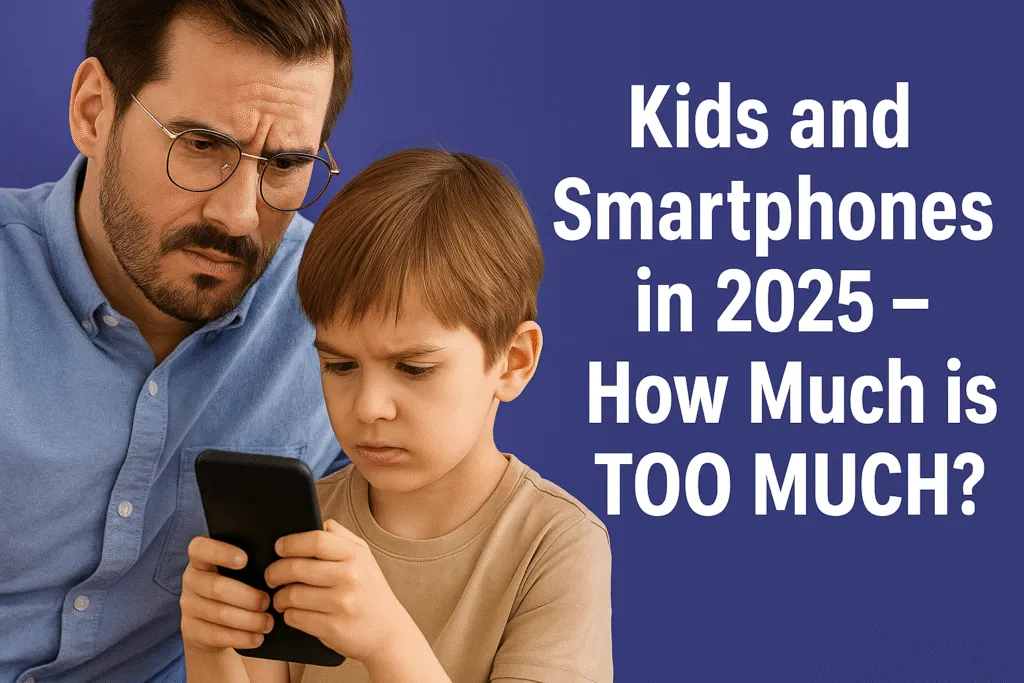Introduction – The Digital Dilemma for Parents
In today’s fast-paced digital world, kids and smartphones have become inseparable. From online classes to entertainment and even social interaction, smartphones play a central role in a child’s daily routine. But with this convenience comes a serious concern for parents — how much is too much?
The rise in smartphone usage among children has sparked debates among educators, doctors, and families alike. On one hand, these devices offer access to knowledge, learning apps, and tools that help in schoolwork. On the other hand, overexposure to screens can affect a child’s mental health, sleep, concentration, and even behavior.
Parents often struggle to strike the right balance between allowing their children to benefit from technology and protecting them from its downsides. Questions like “At what age should my child get a phone?” or “How many hours of screen time is healthy?” are becoming increasingly common in households worldwide.
The concern isn’t just about screen time. It’s also about the type of content children consume, their exposure to social media, and the lack of outdoor or physical activities. For many parents, setting digital boundaries becomes a daily battle — and the lack of clear guidance makes it even harder.
This blog aims to help parents understand the challenges associated with kids and smartphones, and offer practical advice to ensure healthy and mindful usage. Whether your child is asking for their first phone or already owns one, this guide will help you make informed decisions and create habits that promote both safety and balance.
At What Age Should Kids Get Their First Smartphone?
There’s no one-size-fits-all answer to the question of when a child should receive their first smartphone. Every family, child, and situation is different — but it’s one of the most common and sensitive decisions modern parents face. While some kids start using smartphones as early as 8 or 9 years old, many experts suggest waiting until at least age 12 to 14, depending on the child’s maturity, needs, and environment.
Smartphones offer access to the internet, social media, messaging apps, and games — all of which can be beneficial but also carry potential risks. Giving a phone too early can expose children to online dangers such as cyberbullying, screen addiction, and inappropriate content. However, delaying it too long may leave them out of important educational and social experiences, especially in an increasingly digital world.
Instead of focusing strictly on age, consider your child’s emotional readiness and sense of responsibility. Can they follow rules? Do they understand boundaries? Are they capable of handling screen time wisely and using the phone respectfully?
A good approach is to start with a basic phone or restricted smartphone that allows calling, texting, and educational apps — but limits social media and entertainment features. This gives parents time to teach healthy digital habits before giving full access to a smartphone.
You can also set up parental controls, screen time limits, and regular check-ins to monitor usage. Ultimately, the goal is to introduce technology gradually and responsibly — based not just on age, but on trust, maturity, and family values.
Screen Time: What Do Experts Recommend?
When it comes to kids and smartphones, one of the biggest concerns for parents is screen time. How many hours a day is too much? Is all screen time harmful? The answer isn’t just about numbers — it’s about quality, purpose, and balance.
According to the American Academy of Pediatrics (AAP), the recommended screen time varies by age:
- Under 2 years: Avoid screen time altogether, except for video chatting with family.
- 2 to 5 years: Limit screen time to 1 hour per day, focused on high-quality, educational content.
- 6 years and older: No specific limit, but screen time should not interfere with sleep, physical activity, and face-to-face interactions.
Experts emphasize that not all screen time is equal. Watching cartoons for hours differs from using a language-learning app or attending an online class. That’s why they suggest focusing on active vs. passive screen time.
What truly matters is how screens are being used and what’s being compromised because of them. If your child is glued to a phone instead of playing outside, spending time with family, or getting enough sleep — it’s a red flag. But if they’re using their device to learn, create, or connect meaningfully, screen time can be constructive.
Parents are also encouraged to lead by example. When adults model healthy screen habits — like putting phones away during meals or limiting late-night use — kids are more likely to follow suit.
Ultimately, the goal is not to eliminate screens, but to create a balanced routine that includes offline activities, family time, outdoor play, and device-free hours. Being intentional about screen time is key to raising healthy, well-rounded children in a digital age. According to the American Academy of Pediatrics, the recommended screen time varies by age.
Signs Your Child May Be Using the Phone Too Much
It can be difficult to notice when smartphone use becomes excessive — especially since digital devices are now a routine part of schoolwork, socializing, and entertainment. However, there are several warning signs that may indicate your child is becoming overly dependent on their phone.
Here are some key indicators to watch for:
- Sleep Disruption
If your child stays up late scrolling, watching videos, or messaging, and shows signs of tiredness or irritability in the morning, it may be due to too much screen time—especially before bed. - Loss of Interest in Offline Activities
Children who were once active or enjoyed hobbies may lose interest in sports, reading, or spending time with friends or family, preferring their phone over everything else. - Declining Academic Performance
Difficulty concentrating, incomplete homework, or falling grades could be linked to constant phone distractions or late-night usage. - Mood Swings or Anxiety When Without the Phone
If your child becomes unusually angry, anxious, or withdrawn when their phone is taken away or unavailable, it could signal a deeper emotional attachment or dependency. - Secretive Behavior
Hiding screens, quickly switching apps when you walk by, or refusing to share what they’re doing can indicate inappropriate use or unhealthy content exposure. - Neglecting Personal Hygiene or Responsibilities
Ignoring basic self-care routines, skipping meals, or avoiding chores just to spend more time on the phone is another red flag. - Excessive Use of Social Media or Games
Constantly checking notifications, posting frequently, or spending hours on games without breaks are signs of compulsive behavior. - Physical Symptoms
Complaints like eye strain, headaches, or hand and neck pain can result from prolonged phone use without breaks.
Recognizing these signs early allows you to step in before phone use becomes a serious issue. The goal isn’t to punish, but to create healthy tech boundaries through open communication, screen time limits, and more offline engagement. Balance is key to raising digitally aware but emotionally healthy kids.
Psychological and Physical Effects of Overuse
When kids spend excessive time on smartphones, the impact goes far beyond just screen fatigue. Overuse can lead to a wide range of psychological and physical issues that may not be visible immediately but can develop over time.
Psychologically, one of the most noticeable effects is a reduced attention span. Children exposed to fast-moving digital content often find it harder to focus on tasks like reading, writing, or studying. Another concern is anxiety and depression, especially linked to social media. The constant exposure to filtered lifestyles, online comparisons, or negative interactions can lower self-esteem and lead to emotional stress.
Mood swings and irritability are also common. Children may become angry or upset when asked to put down their devices, showing signs of dependency. Sleep is also affected. Blue light from screens interferes with natural sleep patterns, making it harder to fall asleep and leading to tiredness the next day. Over time, this poor sleep can impact mood, memory, and overall well-being. There’s also a social cost. While phones connect kids to others digitally, they may reduce the amount of real-world interaction and communication skills.
Physically, prolonged screen time causes digital eye strain. Children may complain of headaches, dry eyes, or blurry vision. Bad posture while using phones often leads to neck, shoulder, or back pain — sometimes referred to as “text neck.” Reduced physical activity is another concern. When screen time replaces outdoor play or exercise, it can contribute to weight gain and a sedentary lifestyle. Some children may also experience wrist or hand strain from continuous typing or gaming.
These psychological and physical challenges highlight the importance of healthy digital boundaries. Parents should aim for a balance that allows children to benefit from technology without letting it dominate their daily lives. Regular breaks, tech-free zones, and open conversations can go a long way in ensuring that smartphones remain a useful tool — not a harmful habit.
Educational Benefits vs Entertainment Distraction
Smartphones can be powerful educational tools when used correctly. They provide instant access to learning apps, e-books, podcasts, online courses, and educational videos that can supplement schoolwork and encourage curiosity. Many students use smartphones to take notes, research assignments, practice languages, or improve their math and science skills through interactive platforms. Features like voice assistants and screen readers also help children with learning differences access information more easily.
However, the same device that offers learning can quickly become a source of distraction. Social media apps, short-form videos, mobile games, and endless notifications often pull kids away from educational activities. Even during study time, it’s easy for children to switch from a learning app to entertainment content with just a tap. This constant back-and-forth reduces focus, lowers productivity, and makes it difficult to develop discipline around learning.
Another issue is the quality of content. While there are many excellent educational resources available, not all content consumed through smartphones is helpful or reliable. Children may spend hours watching videos or browsing apps that provide little to no educational value. Without supervision or structure, the balance often tilts heavily toward entertainment rather than learning.
To make the most of smartphones, parents and educators must guide children toward high-quality educational apps and set clear boundaries for entertainment. This might include designated study times, app usage limits, and rewards for using devices productively. When managed well, smartphones can support a child’s learning journey — but without guidance, they can easily become a source of distraction rather than development.
Tips for Creating Healthy Smartphone Habits
Developing healthy smartphone habits early on is essential for children to use technology responsibly and safely. It helps prevent overuse, encourages balance, and reduces the risk of mental and physical health issues related to excessive screen time. Here are practical tips parents can follow to promote smarter and healthier smartphone use in kids.
Start by setting clear rules and expectations. Decide together when, where, and how smartphones can be used. For example, no phones during meals, family time, or just before bed. When children are involved in creating these rules, they’re more likely to respect them.
Create screen-free zones in your home. Bedrooms, dining areas, and study spaces can be designated as tech-free areas to encourage better focus, sleep, and interaction. Make sure kids understand that their phone should not interfere with homework, conversations, or physical activity.
Encourage balanced screen time. Use digital well-being tools available on most smartphones to track and limit usage. Set daily time limits for entertainment apps and increase time spent on educational tools or creative activities like drawing, reading, or writing.
Be a good role model. Children often mimic their parents’ behavior, so it’s important to demonstrate balanced smartphone use. Put your own phone away during family time, avoid endless scrolling, and show how devices can be used productively.
Encourage outdoor activities and hobbies. Whether it’s sports, music, puzzles, or crafts, keeping kids engaged offline naturally reduces their dependence on smartphones. Promote real-world interaction by organizing family outings or playdates with friends.
Have open conversations about digital risks. Talk regularly about online safety, privacy, and responsible behavior. Teach them not to share personal information, how to handle unwanted messages, and why it’s okay to take breaks from social media.
Use parental controls where needed. Most phones allow you to restrict content, limit screen time, and monitor usage. These tools help protect children while giving them the space to develop responsibility.
Finally, praise positive usage. When kids use their smartphones wisely — for learning, creativity, or helping others — recognize and reward that behavior. Positive reinforcement strengthens good habits and builds long-term digital discipline.
With the right balance, smartphones can be a valuable part of a child’s life without becoming a constant distraction or a source of harm. The World Health Organization emphasizes that screen time should not replace physical activity.
Parental Control Apps & Monitoring Tools
As smartphones become more central to a child’s daily life, it’s important for parents to maintain some level of oversight — not to invade privacy, but to ensure safety, healthy habits, and appropriate use. That’s where parental control apps and monitoring tools play a vital role. These tools help parents manage screen time, block inappropriate content, track app usage, and even monitor location when necessary.
One of the most widely used tools is Google Family Link. It allows parents to create a supervised account for their child, set daily screen time limits, approve or block app downloads, and even lock the device remotely. It’s ideal for Android users and offers detailed activity reports.
For Apple users, Screen Time is built right into iOS devices. It enables parents to set time limits, content restrictions, app usage reports, and communication limits — all directly through iCloud-connected devices. It works well across iPhones, iPads, and Macs in the family. Tools like Google Family Link allow parents to manage screen time and monitor app usage.
Apps like Qustodio and Bark offer more advanced features such as SMS and social media monitoring, content filtering, and alerts for inappropriate behavior or suspicious online activity. These are helpful for older kids and teens who are active on multiple platforms.
Another popular option is Net Nanny, which offers real-time content filtering, time scheduling, and instant alerts. It works across various devices and helps block harmful websites before they load.
Location tracking features, such as those offered by Life360, allow parents to see where their child is and receive location alerts. This tool is useful for safety, especially when kids start going out on their own.
These apps should be used not as tools of control, but as support systems that promote trust, communication, and digital safety. It’s important to talk openly with children about why these tools are in place and involve them in setting limits. The ultimate goal is to teach kids how to self-regulate and use technology responsibly as they grow.
Balancing Online Safety and Digital Freedom
Striking the right balance between protecting your child online and giving them the freedom to explore is one of the biggest challenges of parenting in the digital age. Too much control can lead to resistance, secrecy, and a lack of trust, while too little oversight can expose kids to serious risks like cyberbullying, scams, or harmful content. The key lies in finding a middle ground where children feel safe, respected, and guided — not controlled.
The first step is building open communication. Instead of relying only on surveillance apps or strict restrictions, have regular conversations about online behavior, safety, and decision-making. Teach your child how to recognize red flags like phishing messages, fake profiles, or unsafe websites. When children understand the reasons behind safety rules, they’re more likely to follow them willingly.
Another important aspect is gradual independence. As children mature, allow them more online freedom in stages. Start with restricted content and gradually expand access based on trust and responsibility. This builds confidence and helps them learn how to manage their digital life without always being monitored.
Respect is also key. Avoid checking your child’s messages or social media without a clear reason. Instead, focus on setting guidelines — like limiting screen time during school nights or requiring approval before downloading apps — that apply to everyone in the family, including adults.
Encourage digital responsibility by showing them how to protect their own privacy, manage settings, and report harmful behavior. Let them know they can come to you without fear if something online makes them uncomfortable.
Balancing online safety and digital freedom isn’t about strict control or complete independence. It’s about guiding children to make smart, ethical, and safe choices while giving them space to grow in the connected world. With trust, structure, and support, kids can learn to enjoy the internet responsibly — without losing their sense of freedom.
Conclusion – Setting Boundaries That Work
In a world where screens are everywhere, managing the relationship between kids and smartphones has become a daily responsibility for modern parents. It’s no longer just about saying “no” to devices — it’s about understanding how to use them wisely, setting the right limits, and guiding children toward balanced digital habits.
Smartphones are not inherently bad. In fact, they offer powerful educational tools, instant communication, creative outlets, and access to knowledge that previous generations never had. But when left unchecked, they can also disrupt sleep, reduce focus, trigger emotional stress, and replace real-world interactions with digital distractions.
That’s why setting boundaries isn’t about restricting access entirely. It’s about helping children develop self-discipline, make informed choices, and understand the impact of their screen habits. Whether it’s limiting screen time, creating phone-free zones at home, or using parental controls — what matters most is consistency, communication, and leading by example.
Each family is different, and the right balance will vary based on age, maturity, and environment. But with clear expectations, mutual respect, and ongoing conversations, parents can create a framework where technology becomes a helpful tool rather than a harmful habit.
Ultimately, the goal is not to remove smartphones from kids’ lives, but to ensure they grow up with the awareness, responsibility, and balance needed to thrive — both online and offline. Setting boundaries today builds healthy digital citizens for tomorrow.
Also Read: BitChat is Here: Break Free from SIM & Internet in 2025!
FAQs – Kids, Screens & Smart Parenting
1. What is the right age to give a smartphone to a child?
There’s no fixed age, but experts suggest waiting until 12–14 years, depending on the child’s maturity and digital responsibility. Some parents start with a basic phone before moving to a full smartphone.
2. How many hours of screen time is safe for kids?
For children aged 2 to 5, limit screen time to 1 hour per day. For older kids, screen time should not interfere with sleep, exercise, or in-person interaction. Focus on quality over quantity.
3. Can smartphones affect my child’s mental health?
Yes, overuse of smartphones, especially social media and gaming, can contribute to anxiety, sleep issues, reduced focus, and social withdrawal if not monitored properly.
4. How do I know if my child is addicted to their phone?
Warning signs include mood swings when the phone is taken away, lack of interest in offline activities, reduced sleep, secrecy, and physical symptoms like eye strain or headaches.
5. Are parental control apps necessary?
Parental controls can be helpful in setting boundaries and ensuring safety. Tools like Google Family Link, Apple Screen Time, and Qustodio allow monitoring without invading privacy.
6. What are some positive uses of smartphones for children?
Smartphones can be used for learning apps, educational videos, language development, reading eBooks, video calls with family, and creative tools like drawing or coding apps.
7. How can I reduce my child’s screen time without conflict?
Use positive reinforcement, create screen-free routines, offer engaging offline alternatives, and involve your child in setting healthy tech rules to gain their cooperation.
8. Should phones be allowed in the bedroom at night?
It’s best to keep phones out of the bedroom to avoid screen exposure before sleep. Night-time phone use is linked to poor sleep quality and reduced focus the next day.
9. Can smartphones be used safely during school hours?
Some schools allow phones for educational purposes, but misuse can lead to distraction. If allowed, set guidelines on when and how your child can use their device.
10. How do I teach my child to be safe online?
Educate them about privacy settings, the dangers of oversharing, how to report harmful content, and the importance of talking to a trusted adult if something feels wrong online.













